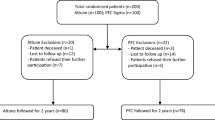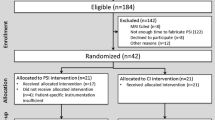Abstract
Background
TKA provides demonstrable pain relief and improved health-related quality of life. Yet, a decline in physical function may occur over the long term despite the absence of implant-related problems.
Questions/purposes
(1) Does pain relief diminish over 20 years after TKA? (2) Does function decline over 20 years in terms of Knee Society function, knee, and walking scores? And (3) what is the patient-reported activity level at most recent followup?
Patients and Methods
We retrospectively identified 1471 patients with 1757 primary cruciate-retaining TKAs implanted between 1975 and 1989 and identified 128 living patients (8.7%) with 171 TKAs. Ninety-three patients were women. We determined Knee Society scores prospectively and UCLA scores retrospectively. Minimum followup was 20 years (average, 21.1 years; range, 20–27 years). Average age at last followup was 82.3 years (range, 45–103 years). Of the 128 patients, 66 (73 TKAs) died after 20-year followup.
Results
Pain scores did not diminish over time (average, 49; range, 20–50). Average knee score was 78 (range, 39–97). Function, stair, and walking scores diminished over time. Average function score was 70 (range, 5–100), primarily due to an average stair score of 35 (range, 0–50); average walking score was 37 (range, 10–50). All but two patients (two TKAs) could negotiate stairs; 95 patients (124 TKAs) could walk at least five blocks; three patients (three TKAs) were housebound. Of the 62 patients still living (98 TKAs), the average UCLA activity score was 8.3 (range, 5–10).
Conclusions
Although aging may cause a gradual decline in physical activity, an improved functional capacity and activity level continue 20 years or more after TKA.
Level of Evidence
Level IV, therapeutic study. See Guidelines for Authors for a complete description of levels of evidence.
Similar content being viewed by others
References
Amstutz HC, Thomas BJ, Jinnah R, Kim W, Grogan T, Yale C. Treatment of primary osteoarthritis of the hip: a comparison of total joint and surface replacement arthroplasty. J Bone Joint Surg Am. 1984;66:228–241.
Bauman S, Williams D, Petruccelli D, Elliot W, de Beer J. Physical activity after total joint replacement; a cross-sectional survey. Clin J Sports Med. 2007;17:104–108.
Benjamin J, Johnson R, Porter S. Knee scores change with length of follow-up after total knee arthroplasty. J Arthroplasty. 2003;18:867–871.
Callaghan JJ, Wells CW, Liu SS, Goetz DD, Johnston RC. Cemented rotating-platform total knee replacement. J Bone Joint Surg Am. 2010;92:1635–1639.
Dahm DL, Barnes SA, Harrington JR, Sayeed SA, Berry DJ. Patient-reported activity level after total knee arthroplasty. J Arthroplasty. 2008;23:401–407.
Diduch DR, Insall JN, Scott WN, Scuderi GR, Font-Rodriguez D. Total knee replacement in young, active patients: long-term follow-up and functional outcome. J Bone Joint Surg Am. 1997;79:575–582.
Ethgen O, Bruyere O, Richy F, Dardennes C, Reginster JY. Health-related quality of life in total hip and total knee arthroplasty: a qualitative and systematic review of the literature. J Bone Joint Surg Am. 2004;86:963–974.
Ewald FC. The Knee Society total knee arthroplasty roentgenographic evaluation and scoring system. Clin Orthop Relat Res. 1989;248:9–12.
Fisher N, Agarwal M, Reuben SF, Johnson DS, Turner PG. Sporting and physical activity following Oxford medial unicompartmental knee arthroplasty. Knee. 2006;13:296–300.
Font-Rodriguez DE, Scuderi GR, Insall JN. Survivorship of cemented total knee arthroplasty. Clin Orthop Relat Res. 1997;345:79–86.
Gill GS, Joshi AB. Long-term results of Kinematic Condylar knee replacement: an analysis of 404 knees. J Bone Joint Surg Br. 2001;83:355–358.
Hawker G, Wright J, Coyte P, Paul J, Dittus R, Croxford R, Katz B, Bombardier C, Heck D, Freund D. Health-related quality of life after knee replacement: results of the Knee Replacement Patient Outcomes Research Team study. J Bone Joint Surg Am. 1998;80:163–173.
Insall JN, Dorr LD, Scott RD, Scott WN. Rationale of the Knee Society clinical rating system. Clin Orthop Relat Res. 1989;248:13–14.
Joshi AB, Gill GS, Smith PL. Outcome in patients lost to followup. J Arthroplasty. 2003;18:149–153.
König A, Scheidler M, Rader C, Eulert J. The need for a dual rating system in total knee arthroplasty. Clin Orthop Relat Res. 1997;345:161–167.
Ma HM, Lu YC, Ho FY, Huang CH. Long-term results of Total Condylar knee arthroplasty. J Arthroplasty. 2005;20:580–584.
Malkani AL, Rand JA, Bryan RS, Wallrichs SL. Total knee arthroplasty with the Kinematic Condylar prosthesis: a ten-year follow-up study. J Bone Joint Surg Am. 1995;77:423–431.
Naal FD, Impellizzeri FM, Leunig M. Which is the best activity rating scale for patients undergoing total joint arthroplasty? Clin Orthop Relat Res. 2009;467:958–965.
NIH Consensus Panel. NIH consensus statement on total knee replacement December 8–10, 2003. J Bone Joint Surg Am. 2004;86:1328–1335.
Norman-Taylor FH, Palmer CR, Villar RN. Quality-of-life improvement compared after hip and knee replacement. J Bone Joint Surg Br. 1996;78:74–77.
Pavone V, Boettner F, Fickert S, Sculco TP. Total Condylar knee arthroplasty: a long-term follow-up. Clin Orthop Relat Res. 2001;388:18–25.
Ritter MA. The Anatomical Graduated Component total knee replacement. J Bone Joint Surg Br. 2009;91:745–749.
Ritter MA, Meneghini RM. Twenty-year survivorship of cementless Anatomic Graduated Component total knee arthroplasty. J Arthroplasty. 2010;25:507–513.
Ritter MA, Thong AE, Davis KE, Berend ME, Meding JB, Faris PM. Long-term deterioration of joint evaluation scores. J Bone Joint Surg Br. 2004;86:438–442.
Rodriguez JA, Bhende H, Ranawat CS. Total Condylar Knee replacement: a 20-year follow-up study. Clin Orthop Relat Res. 2001;388:10–17.
Schmalzried TP, Szuszczewicz ES, Northfield MR, Akizuki KH, Frankel RE, Belcher G, Amstutz HC. Quantitative assessment of walking activity after total hip or knee replacement. J Bone Joint Surg Am. 1998;80:54–59.
US National Center for Health Statistics. United States life tables. Natl Vital Stat Rep. 2008;57:1–40.
US National Center for Health Statistics. Deaths: final data for 2006. Natl Vital Stat Rep. 2009;57:1–136.
Wright J, Ewald FC, Walker PS, Thomas WH, Poss R, Sledge CB. Total knee arthroplasty with the Kinematic prosthesis. J Bone Joint Surg Am. 1990;72:1003–1009.
Zahiri CA, Schmalzried TP, Szuszczewicz ES, Amstutz HC. Assessing activity in joint replacement patients. J Arthroplasty. 1998;13:890–895.
Acknowledgments
We thank Philip M. Faris, MD, who along with Merrill A Ritter, MD, and E. Michael Keating, MD, were orthopaedic surgeons for the patient population included in this study.
Author information
Authors and Affiliations
Corresponding author
Additional information
Each author certifies that he or she has no commercial associations (eg, consultancies, stock ownership, equity interest, patent/licensing arrangements, etc) that might pose a conflict of interest in connection with the submitted article.
Clinical Orthopaedics and Related Research neither advocates nor endorses the use of any treatment, drug, or device. Readers are encouraged to always seek additional information, including FDA approval status, of any drug or device before clinical use.
Each author certifies that his or her institutional approved the human protocol for this investigation, that all investigations were conducted in conformity with ethical principles of research, and that informed consent for participation in the study was obtained.
About this article
Cite this article
Meding, J.B., Meding, L.K., Ritter, M.A. et al. Pain Relief and Functional Improvement Remain 20 Years After Knee Arthroplasty. Clin Orthop Relat Res 470, 144–149 (2012). https://doi.org/10.1007/s11999-011-2123-4
Published:
Issue Date:
DOI: https://doi.org/10.1007/s11999-011-2123-4




